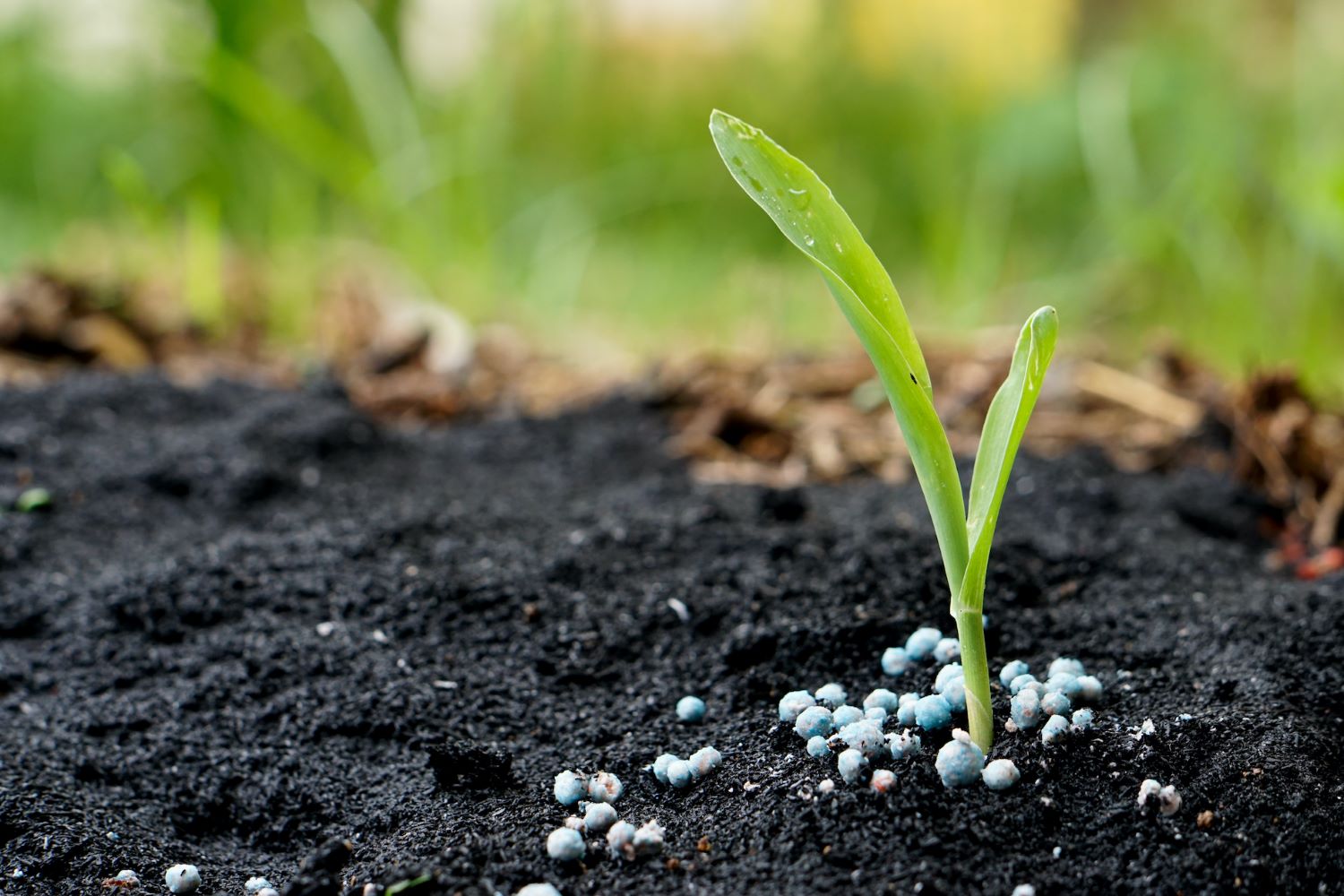

Articles
How Long Does It Take For Fertilizer To Work
Modified: October 20, 2024
Learn how long it takes for fertilizer to work in our informative articles. Discover the factors that influence its effectiveness and maximize your garden's growth.
(Many of the links in this article redirect to a specific reviewed product. Your purchase of these products through affiliate links helps to generate commission for Storables.com, at no extra cost. Learn more)
Introduction
Welcome to our comprehensive guide on “How Long Does It Take For Fertilizer To Work?”. Whether you’re an experienced gardener looking to optimize your plant growth or a novice trying to understand the complexities of fertilizer application, this article will provide you with valuable insights into the factors affecting fertilizer performance and the time frame for seeing results.
Fertilizers play a crucial role in enhancing plant growth and maximizing yields. They provide essential nutrients that may be lacking in the soil, ensuring that plants have an adequate supply to support their growth and development. However, understanding the timeline and factors influencing fertilizer effectiveness is vital to achieve the desired results.
In this article, we will delve into the various factors that impact fertilizer performance, the different types of fertilizers, and the time it takes for fertilizers to take effect. We will also discuss the environmental factors that can affect fertilizer efficiency and provide some best practices for maximizing the benefits of fertilizers.
By the end of this guide, you will have a comprehensive understanding of how long it typically takes for fertilizers to work and how to ensure optimal results for your plants. Let’s dive in!
Key Takeaways:
- Understanding the factors affecting fertilizer performance, nutrient availability, and environmental influences is crucial for optimizing plant growth and maximizing yields.
- By following best practices such as proper soil testing, fertilizer selection, and environmental management, you can maximize fertilizer effectiveness and promote sustainable gardening or farming practices.
Read more: How Long Does It Take A Humidifier To Work
Factors Affecting Fertilizer Performance
Several factors can influence the overall performance of fertilizers. It’s essential to consider these factors to ensure that the nutrients in the fertilizers are effectively absorbed by the plants. Let’s explore some of the key factors below:
- Soil pH: The pH level of the soil greatly affects the availability of nutrients to plants. Each nutrient has its optimum pH range for absorption. For example, acidic soils can limit the availability of nutrients like phosphorus and calcium, while alkaline soils can restrict the uptake of nutrients such as iron and zinc. Fertilizers should be chosen based on the pH requirements of the plants being grown.
- Nutrient Balance: A balanced nutrient profile is crucial for healthy plant growth. Different types of plants have varying nutrient requirements, and a deficiency or excess of certain nutrients can affect their development. Fertilizers should be formulated to meet the specific nutrient needs of the plants being cultivated.
- Application Method: The method used to apply fertilizers can impact their effectiveness. Surface application, where fertilizers are spread on the soil surface, may be suitable for certain plants, while others may benefit from localized placement or incorporation into the soil. The chosen method should ensure that the nutrients reach the root zone of the plants.
- Watering and Irrigation: Adequate moisture is essential for the proper uptake of nutrients by plants. Insufficient watering can limit the movement of nutrients through the soil, while excessive irrigation can lead to nutrient leaching. Proper watering practices that allow for optimal nutrient absorption should be followed.
- Temperature and Weather Conditions: Temperature and weather conditions can have a significant impact on fertilizer performance. Cold temperatures can slow down nutrient uptake, while excessive heat can lead to nutrient loss through evaporation. It’s important to consider the climatic conditions when applying fertilizers to maximize their effectiveness.
- Soil Organic Matter: The presence of organic matter in the soil can improve nutrient retention and release. Organic matter enhances the soil’s ability to hold water and nutrients, providing a steady supply for plant uptake. Adding organic matter to the soil through the use of compost or organic fertilizers can improve fertilizer performance.
- Microbial Activity: Soil microorganisms play a vital role in breaking down organic matter and releasing nutrients in a plant-available form. The presence of a diverse and active microbial population promotes nutrient cycling, making the nutrients more accessible to plants. Practices that support healthy soil microbiology, such as avoiding overuse of chemical fertilizers and incorporating organic matter, can improve fertilizer performance.
By considering these factors and making the necessary adjustments, you can significantly enhance the performance of fertilizers and ensure that your plants receive the nutrients they need for optimal growth and development.
Nutrient Availability in Different Types of Fertilizers
When it comes to fertilizers, there are several different types available, each with its own nutrient composition and availability. Understanding the nutrient availability of different fertilizers is crucial in selecting the right one for your plants. Let’s take a closer look at some common types of fertilizers and their nutrient profiles:
- Inorganic or Synthetic Fertilizers: Inorganic fertilizers are manufactured using chemical processes and typically have a high concentration of nutrients. They provide readily available forms of essential nutrients such as nitrogen (N), phosphorus (P), and potassium (K). These fertilizers offer quick-release nutrients that are readily absorbed by plants, making them ideal for providing immediate growth responses.
- Organic Fertilizers: Organic fertilizers are derived from natural sources such as plant matter, animal manure, and compost. They contain a lower concentration of nutrients compared to synthetic fertilizers but provide a slow-release form of nutrition. Organic fertilizers release nutrients gradually as they decompose, making them a more sustainable option. They also help improve soil structure and stimulate microbial activity, enhancing nutrient availability in the long run.
- Controlled-Release Fertilizers: Controlled-release fertilizers consist of coated granules that release nutrients over an extended period. These fertilizers offer a controlled release mechanism, ensuring a steady supply of nutrients to plants. The release rate can be tailored based on the specific needs of the plants, providing a more efficient and sustained nutrient availability. Controlled-release fertilizers are particularly beneficial in situations where frequent fertilizer applications are not feasible.
- Liquid Fertilizers: Liquid fertilizers are water-soluble formulations that can be easily applied to the soil or foliar sprayed on plants. They provide rapid nutrient uptake as they are quickly absorbed by plant roots or leaves. Liquid fertilizers are highly versatile, allowing for precise nutrient application and ease of use. They are commonly used in hydroponic systems or for foliar feeding, where nutrients are directly sprayed onto the plant foliage.
- Natural Amendments: Natural amendments, such as bone meal, blood meal, and fish emulsion, are mineral-rich products that provide specific nutrients to plants. These amendments are commonly used to address specific nutrient deficiencies or promote targeted growth, such as encouraging flowering or fruiting. Natural amendments often require organic matter decomposition or microbial activity for nutrient release.
Each type of fertilizer has its advantages and considerations, depending on the specific needs of your plants and the soil conditions. It’s important to assess the nutrient requirements of your plants and choose a fertilizer that provides the necessary nutrients in a form that promotes optimal uptake and utilization.
Keep in mind that while inorganic and liquid fertilizers offer quick results, organic fertilizers and natural amendments provide long-term benefits for soil health and sustainability. A combination of different fertilizers may be the most effective approach to ensure balanced nutrient availability throughout the growing season.
By understanding the nutrient availability of different fertilizers, you can make informed choices to maximize the growth and productivity of your plants while promoting environmental stewardship.
Time Frame for Fertilizer Action
The time it takes for fertilizers to take effect and for plants to show visible growth responses can vary depending on multiple factors. Understanding the time frame for fertilizer action is important for managing expectations and adjusting applications as needed. Let’s explore the general time frame for fertilizer action:
- Immediate Effects: Some fertilizers, particularly inorganic or synthetic fertilizers, provide immediate effects due to their quick-release nature. These fertilizers contain nutrients that are readily available for plant uptake, and you may start to see visible growth responses within a few days to a week after application. This rapid action makes them useful for correcting nutrient deficiencies or providing a boost during critical growth stages.
- Short-Term Effects: Many fertilizers, including controlled-release fertilizers and liquid fertilizers, offer short-term effects. Controlled-release fertilizers release nutrients gradually over a period of weeks to months, providing a sustained supply of nutrients to plants. Liquid fertilizers can be quickly absorbed by plant roots or foliage, resulting in rapid growth responses. These fertilizers typically show visible effects within a few weeks after application.
- Long-Term Effects: Organic fertilizers and natural amendments provide long-term effects for plant growth. These fertilizers release nutrients slowly as they decompose, improving soil fertility and promoting microbial activity. It may take several weeks to months for the organic matter to break down and release nutrients, leading to steady and sustained growth responses in plants over time. The long-term benefits of organic fertilizers contribute to improved soil structure and overall plant health.
- Plant-specific Effects: Different plant species and varieties have varying growth rates and nutrient requirements. Some plants may show quick growth responses to fertilizer applications, while others may take longer to exhibit visible effects. Additionally, the stage of plant development also plays a role in how quickly plants respond to fertilizers. Young plants and actively growing plants tend to show faster growth responses compared to established or dormant plants.
- Environmental Factors: Environmental conditions such as temperature, moisture, and sunlight also impact the timeframe for fertilizer action. Optimal growing conditions, including adequate moisture and temperature ranges, promote efficient nutrient uptake and utilization by plants. Adverse environmental conditions, such as extreme heat or drought, can hinder fertilizer effectiveness and delay growth responses.
It’s important to note that fertilizer action is not solely dependent on the time frame but also on the overall health and conditions of the plants, as well as other external factors. Regular monitoring of plant growth, proper fertilization schedules, and adjustments based on plant responses and soil testing will help ensure the timely and effective performance of fertilizers.
Remember, patience is key when it comes to fertilizer action. While some fertilizers yield quick results, others may take longer to show visible effects. By understanding the general time frame for fertilizer action and considering the specific needs of your plants, you can optimize fertilizer applications and promote healthy growth and development.
The time it takes for fertilizer to work depends on the type of fertilizer, soil conditions, and weather. Generally, it can take a few weeks to a few months to see noticeable results.
Environmental Factors Influencing Fertilizer Efficiency
Various environmental factors can significantly impact the efficiency of fertilizers, affecting how effectively plants absorb and utilize the nutrients. Understanding these factors is crucial for optimizing fertilizer effectiveness and minimizing nutrient loss. Let’s explore some of the key environmental factors that influence fertilizer efficiency:
- Soil Moisture: Adequate soil moisture is essential for nutrient uptake by plant roots. Dry soil conditions can hinder the movement of nutrients, limiting their availability to plants. On the other hand, excessive moisture can cause nutrient leaching, where essential nutrients wash away from the root zone, rendering them inaccessible to plants. Maintaining appropriate soil moisture levels through proper irrigation practices is essential for maximizing fertilizer efficiency.
- Temperature: Temperature plays a significant role in nutrient availability and uptake. Cold temperatures can slow down soil microbial activity, reducing the breakdown of organic matter and nutrient release. Different nutrients have specific temperature optima for uptake by plant roots. Extreme temperature fluctuations can also impact root function and nutrient absorption. Maintaining moderate and consistent temperatures is important for optimal fertilizer efficiency.
- Soil pH: Soil pH affects the chemical properties of the soil and can influence nutrient availability. Different nutrients have varying solubilities at different pH levels. For example, acidic soils can limit the availability of nutrients like phosphorus and calcium, while alkaline soils can restrict the uptake of iron and zinc. It’s important to monitor the pH of the soil and adjust it if necessary to ensure proper nutrient availability and fertilizer efficiency.
- Soil Texture and Composition: Soil texture refers to the proportion of sand, silt, and clay particles in the soil. Different soil textures have varying water-holding capacities and nutrient retention capabilities. Sandy soils drain quickly, which can lead to nutrient leaching, while clay soils can retain water and nutrients, making them prone to nutrient runoff. Amending the soil with organic matter can improve soil structure, water-holding capacity, and nutrient retention, enhancing fertilizer efficiency.
- Soil Microbes: Soil microorganisms play a vital role in nutrient cycling and availability. Beneficial microbes break down organic matter and convert nutrients into plant-available forms. Imbalanced or excessive use of chemical fertilizers can negatively impact soil microbiology, reducing microbial activity and nutrient release. Maintaining a healthy soil microbial population through organic matter application and avoiding excessive use of chemical fertilizers can enhance fertilizer efficiency.
- Wind and Erosion: Strong winds can cause soil erosion, which can result in loss of topsoil and nutrient-rich organic matter. This can lead to nutrient depletion and reduced fertilizer efficacy. Implementing erosion control measures, such as windbreaks and cover crops, can help minimize nutrient loss through erosion and maintain soil fertility.
- Competition and Plant Density: Plant density and competition for nutrients can affect fertilizer efficiency. When plants are densely spaced, they may compete for limited nutrients, reducing individual plant nutrient uptake. Proper spacing and avoiding overplanting can help ensure adequate nutrient availability for each plant, maximizing fertilizer efficiency.
By considering these environmental factors and implementing appropriate management practices, you can enhance the efficiency of fertilizers and improve plant nutrient uptake. Regular soil testing, proper irrigation, maintaining optimal pH levels, and promoting soil microbiology are essential for ensuring that fertilizers are utilized efficiently by plants.
Remember, maintaining a balanced and healthy environment is key to maximizing fertilizer effectiveness and achieving optimal plant growth and yields.
Best Practices for Maximizing Fertilizer Effectiveness
To maximize the effectiveness of fertilizers and ensure that plants receive the nutrients they need for optimal growth and productivity, it is important to follow some best practices. Incorporating these practices into your fertilization routine will help optimize nutrient uptake and minimize nutrient loss. Let’s explore some of the best practices for maximizing fertilizer effectiveness:
- Soil Testing: Conduct regular soil testing to understand the nutrient levels and pH of your soil. This will help you determine the specific nutrient requirements of your plants and allow you to tailor your fertilizer application accordingly. By applying only the necessary nutrients, you can avoid over-fertilization, which can lead to nutrient runoff and environmental pollution.
- Choose the Right Fertilizer: Select fertilizers that are appropriate for your plants’ needs and the soil conditions. Consider factors such as nutrient composition, release rates, and application methods. Different stages of plant growth may require different nutrient ratios, so adjust your fertilizer selection accordingly.
- Proper Application: Follow the recommended application rates and techniques for the chosen fertilizer. Avoid applying more fertilizer than needed, as excess nutrients can leach into water bodies or contribute to soil pollution. Ensure an even and uniform distribution of fertilizers to prevent nutrient imbalances and uneven plant growth.
- Timing: Timing is crucial when it comes to fertilizer application. Apply fertilizers at the appropriate growth stages to provide nutrients when plants need them the most. Pre-planting, side-dressing, or top-dressing techniques can be employed based on plant requirements and fertilizer characteristics.
- Proper Irrigation: Water management is closely linked to fertilizer effectiveness. Irrigate your plants properly to ensure that water and nutrients efficiently reach the root zone. Avoid overwatering, as excessive irrigation can lead to nutrient leaching. Implement irrigation methods that promote water conservation and minimize nutrient loss.
- Manage Organic Matter: Incorporating organic matter into the soil can help improve soil structure, water-holding capacity, and nutrient retention. Organic matter acts as a slow-release fertilizer, providing plants with a steady supply of nutrients over time. Use compost, cover crops, or other organic amendments to enhance soil fertility and maximize fertilizer efficiency.
- Maintain Soil Health: Foster a healthy soil environment by promoting beneficial microbial activity. Avoid excessive use of chemical fertilizers and pesticides, as they can disrupt soil microbiology. Implement crop rotation and cover cropping practices to improve soil health, enhance nutrient cycling, and minimize disease and pest issues.
- Monitor Plant Response: Regularly observe and assess your plants for signs of nutrient deficiency or excess. Adjust your fertilization practices accordingly to address any imbalances or deficiencies that may arise. Visual symptoms, such as leaf discoloration or stunted growth, can provide valuable insights into the plant’s nutrient needs.
- Follow Local Regulations and Guidelines: Be aware of and adhere to local regulations and guidelines regarding fertilizer use. These regulations are in place to protect the environment and ensure sustainable agricultural practices. By following these guidelines, you can contribute to the overall health of ecosystems and minimize the negative impact of fertilizer application.
By following these best practices, you can maximize the effectiveness of fertilizers, promote healthy plant growth, and minimize environmental impacts. Remember, a balanced and thoughtful approach to fertilization will lead to more sustainable and productive gardening or farming practices.
Conclusion
Understanding how long it takes for fertilizer to work and the factors influencing its performance is essential for ensuring optimal plant growth and maximizing yields. Throughout this guide, we have explored various aspects related to fertilizer effectiveness, including the factors affecting fertilizer performance, nutrient availability in different types of fertilizers, the timeframe for fertilizer action, environmental factors influencing fertilizer efficiency, and best practices for maximizing fertilizer effectiveness.
By considering factors such as soil pH, nutrient balance, application methods, and environmental conditions, you can make informed choices when selecting and applying fertilizers. Soil testing and regular monitoring of plant growth will help gauge nutrient needs and fine-tune fertilizer applications for better results. Choosing the right fertilizer type and timing its application according to plant growth stages are critical for promoting healthy and productive plants.
Environmental factors such as soil moisture, temperature, wind, and soil composition also play a vital role in fertilizer efficiency. By managing these factors effectively, you can minimize nutrient loss and ensure that nutrients are readily available for plant uptake.
Incorporating best practices such as proper irrigation, organic matter management, maintaining soil health, and monitoring plant response will contribute to maximizing fertilizer effectiveness and maintaining a sustainable agricultural approach. Adhering to local regulations and guidelines for fertilizer use is essential to minimize environmental impacts and promote responsible stewardship of our ecosystems.
Remember that fertilizer action can vary depending on plant species, environmental conditions, and the specific fertilizer used. Patience and regular observation of plant response are key to understanding the effectiveness of fertilizers and making necessary adjustments to promote healthy plant growth.
By following the guidelines and recommendations provided in this article, you can optimize fertilizer effectiveness, promote plant vitality, and contribute to sustainable and fruitful gardening or farming practices. With the right knowledge and practices, you can enjoy the rewards of lush and thriving plants while minimizing environmental impact.
Frequently Asked Questions about How Long Does It Take For Fertilizer To Work
Was this page helpful?
At Storables.com, we guarantee accurate and reliable information. Our content, validated by Expert Board Contributors, is crafted following stringent Editorial Policies. We're committed to providing you with well-researched, expert-backed insights for all your informational needs.















0 thoughts on “How Long Does It Take For Fertilizer To Work”